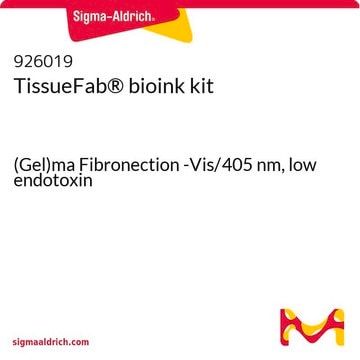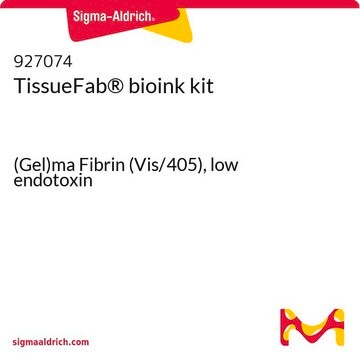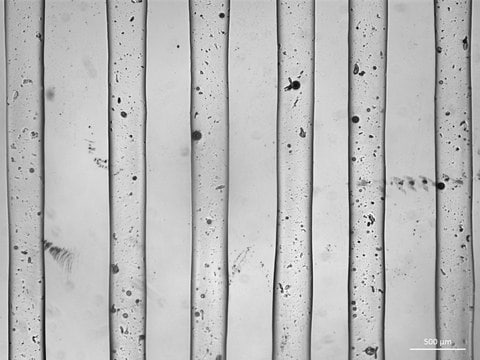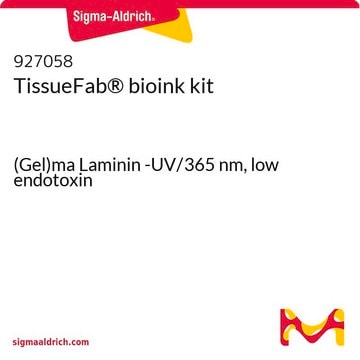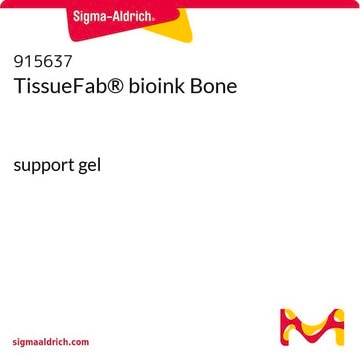推薦產品
形狀
viscous liquid (gel)
尺寸
10 mL
雜質
<5 cfu/mL Bioburden
<50 EU/mL Endotoxin
顏色
pale yellow to colorless
pH值
6.5-7.5
黏度
3-30 cP
應用
3D bioprinting
儲存溫度
−20°C
尋找類似的產品? 前往 產品比較指南
一般說明
Gelatin methacryloyl (GelMA) is a polymerizable hydrogel material derived from natural extracellular matrix (ECM) components. Due to its low cost, abundance, and retention of natural cell binding motifs, gelatin has become a highly sought material for tissue engineering applications. Laminin is an extracellular matrix multidomain trimeric glycoprotein and is the main non-collagenous component of basal lamina that supports adhesion, proliferation and differentiation. Laminin is composed of both A, B1 and B2 chains, which are connected by many disulfide bonds. This laminin product was isolated from mouse Engelbreth-Holm-Swarm tumor. Laminin proteins are integral components of structural scaffolding in animal tissues. They associate with type IV collagen via entactin and perlecan and bind to cell membranes through integrin receptors, dystroglycan glycoprotein complexes and Lutheran blood group glycoproteins.
應用
The addition of photocrosslinkable methacrylamide functional groups in GelMA allows the synthesis of biocompatible, biodegradable, and non-immunogenic hydrogels that are stable in biologically relevant conditions and promote cell adhesion, spreading, and proliferation Gelatin methacrylate based bioinks have been used to bioprint osteogenic [1], chondrogenic [2-3], hepatic [4-6], adipogenic [7], vasculogenic [8], epithelial [6], endothelial [9-10], cardiac valve [11], skin [12], tumor [10] and other tissues and constructs. Laminin has active domains for collagen binding, cell adhesion, heparin binding, and neurite outgrowth fragment. Laminin has been used in tissue engineering applications for corneal [13], organoids[14] and neurodegenerative diseases [15-16].
特點和優勢
In addition to fast gelation, the methacrylamide functional group can also be used to control the hydrogel physical parameters such as pore size, degradation rate, and swell ratio. Temporal and spatial control of the crosslinking reaction can be obtained by adjusting the degree of functionalization and polymerization conditions, allowing for the fabrication of hydrogels with unique patterns, 3D structures, and morphologies.
法律資訊
TISSUEFAB is a registered trademark of Merck KGaA, Darmstadt, Germany
儲存類別代碼
10 - Combustible liquids
閃點(°F)
Not applicable
閃點(°C)
Not applicable
分析證明 (COA)
輸入產品批次/批號來搜索 分析證明 (COA)。在產品’s標籤上找到批次和批號,寫有 ‘Lot’或‘Batch’.。
Anni Sorkio et al.
Biomaterials, 171, 57-71 (2018-04-24)
There is a high demand for developing methods to produce more native-like 3D corneal structures. In the present study, we produced 3D cornea-mimicking tissues using human stem cells and laser-assisted bioprinting (LaBP). Human embryonic stem cell derived limbal epithelial stem
Daniela Barros et al.
Biomaterials science, 7(12), 5338-5349 (2019-10-18)
Laminin incorporation into biological or synthetic hydrogels has been explored to recapitulate the dynamic nature and biological complexity of neural stem cell (NSC) niches. However, the strategies currently explored for laminin immobilization within three-dimensional (3D) matrices do not address a
Nicolas Broguiere et al.
Advanced materials (Deerfield Beach, Fla.), 30(43), e1801621-e1801621 (2018-09-12)
Epithelial organoids are simplified models of organs grown in vitro from embryonic and adult stem cells. They are widely used to study organ development and disease, and enable drug screening in patient-derived primary tissues. Current protocols, however, rely on animal-
Rachel R Besser et al.
Biomaterials science, 8(2), 591-606 (2019-12-21)
We report a water-soluble and non-toxic method to incorporate additional extracellular matrix proteins into gelatin hydrogels, while obviating the use of chemical crosslinkers such as glutaraldehyde. Gelatin hydrogels were fabricated using a range of gelatin concentrations (4%-10%) that corresponded to
Wanjun Liu et al.
Advanced healthcare materials, 6(12) (2017-05-04)
Bioprinting is an emerging technique for the fabrication of 3D cell-laden constructs. However, the progress for generating a 3D complex physiological microenvironment has been hampered by a lack of advanced cell-responsive bioinks that enable bioprinting with high structural fidelity, particularly
文章
Learn how 3D bioprinting is revolutionizing drug discovery with highly-controllable cell co-culture, printable biomaterials, and its potential to simulate tissues and organs. This review paper also compares 3D bioprinting to other advanced biomimetic techniques such as organoids and organ chips.
我們的科學家團隊在所有研究領域都有豐富的經驗,包括生命科學、材料科學、化學合成、色譜、分析等.
聯絡技術服務